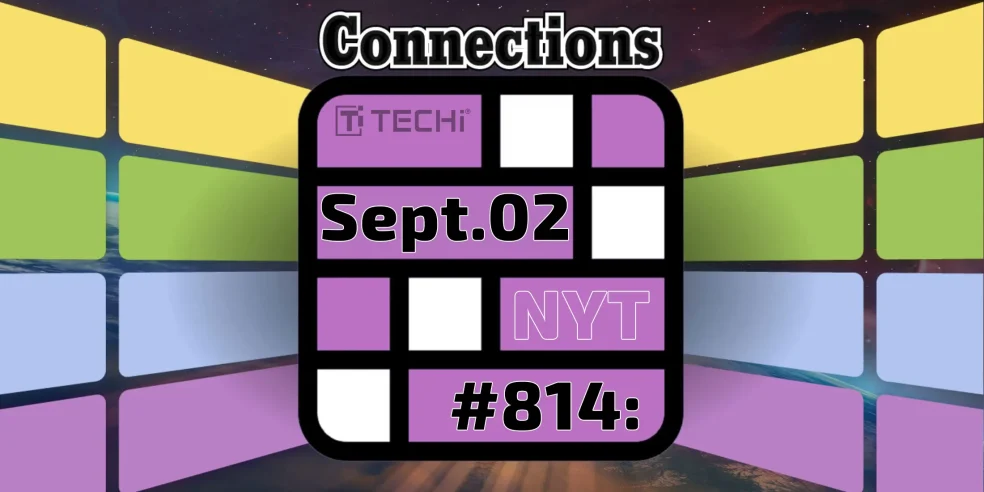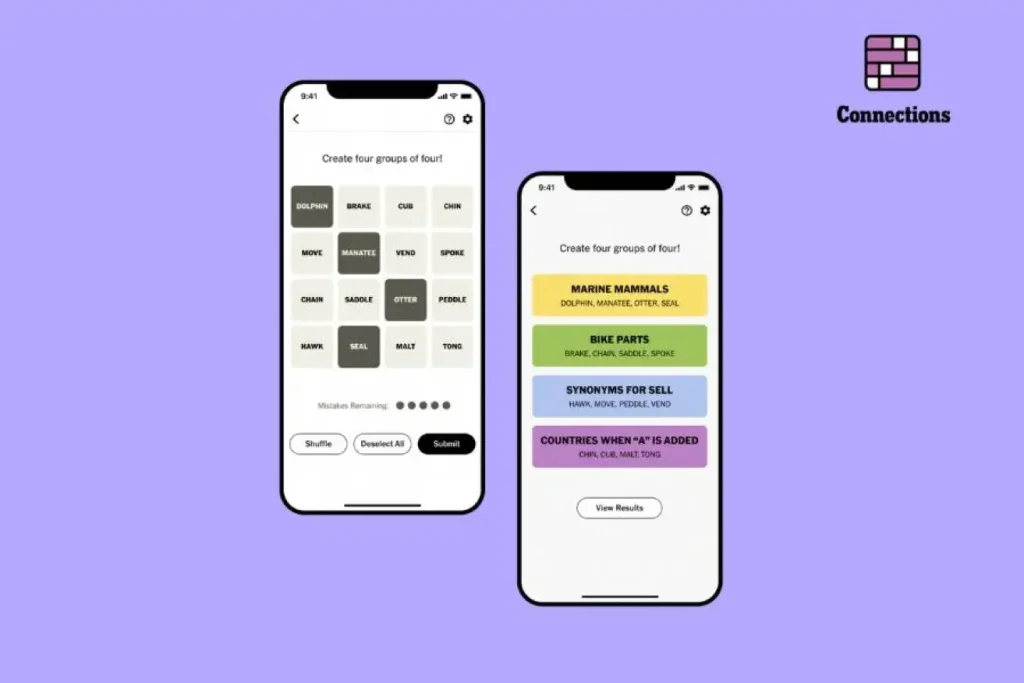Word puzzles have taken the internet by storm, and millions of players around the world now include them in their daily routine. After the phenomenal success of Wordle, the New York Times expanded its puzzle collection with a new and unique challenge called NYT Connections. Unlike Wordle, which asks players to guess a hidden five-letter word, Connections presents 16 words that need to be sorted into four categories based on common themes. It sounds simple, but the challenge lies in recognizing subtle connections while avoiding traps that seem right at first glance but lead to mistakes.
Every day, thousands of players search for “NYT Connections answers today”, “today’s puzzle categories”, or “daily NYT Connections hints.” If you are one of those players, this guide is for you. In the following sections, we will explain how the game works, reveal today’s categories and answers, and provide strategies to sharpen your skills so you can solve the puzzle more consistently.
What is NYT Connections?
NYT Connections is a daily word puzzle game created by the New York Times in June 2023. The core idea is simple: you are given a grid of sixteen words and must divide them into four correct groups. Each group shares a hidden theme, such as types of fruit, movie titles, or musical instruments.
The categories are color-coded to represent their level of difficulty. The green category is the easiest and usually contains the most obvious connections. The yellow category represents a moderate challenge and often includes words that seem unrelated at first glance but reveal a clear link once identified. The blue category tends to be trickier, as it involves words that may have multiple meanings or more abstract associations. Finally, the purple category is the hardest of all and often surprises players with its subtle or unexpected theme.
Players only have four mistakes before the game ends, which means you cannot rely on random guessing. This limitation adds suspense to every move. Because the rules are easy to understand but the solutions require clever thinking, Connections quickly became one of the most played games on the NYT platform, second only to Wordle.
NYT Connections Today – Puzzle Categories & Themes

Let’s focus on the reason most readers land on this page: today’s puzzle. Each day brings a fresh set of words and new categories. For example, on a given day, the green category may involve fruits such as apples, bananas, oranges, and grapes. The yellow category might highlight musical instruments such as guitar, piano, drums, and violin. The blue category could test abstract thinking with synonyms for speed, including rapid, swift, quick, and speedy. The purple category, often the trickiest, might bring together Shakespearean characters like Hamlet, Othello, Macbeth, and Lear.
This structure demonstrates how varied and challenging the puzzles can be. Sometimes the groups are straightforward, while other times they require cultural knowledge, linguistic skills, or lateral thinking. By presenting the answers in categories rather than a simple list, players can better understand the reasoning behind the connections and learn to recognize similar patterns in future puzzles.
Step-by-Step Guide to Solving NYT Connections
- Scan the grid for obvious groups – Start by spotting four words that clearly belong together, such as colors, fruits, or animals. These are usually the easiest categories to solve.
- Lock the easy groups first – If a set of words clearly forms a theme, group them early to reduce the number of remaining words.
- Flag tricky words – Some words may have multiple meanings, like bass, which could refer to a fish or a musical instrument. Avoid committing these until later.
- Look for unique or proper nouns – Famous names, brands, or place names often form their own category and can give quick clues.
- Test combinations mentally before selecting – Pair two or three words in your mind and see which fourth word completes the group logically.
- Use elimination after confirming other groups – Once two or three groups are correct, the remaining words usually form the last category automatically.
- Watch out for false groups – Sometimes five words seem connected, but one of them belongs elsewhere. Double-check before committing.
- Save hard categories for last – Tackle easy and medium groups first (green/yellow) so the difficult ones (blue/purple) become clearer with fewer remaining words.
- Manage your four mistakes wisely – Avoid random guesses. Only submit groups when you’re reasonably confident to prevent game over.
- Practice regularly and review mistakes – Daily play improves pattern recognition and helps you learn from tricky words you previously missed.
NYT Connections Hints vs Answers
Some players prefer hints rather than full solutions. Hints provide just enough information to nudge you in the right direction without spoiling the challenge. For example, instead of giving you the exact words, a hint might say: “Look for four items you might find in a kitchen.” This allows you to keep the puzzle fun while still receiving guidance.
Other players want immediate answers, especially if they are stuck on the last category or if they have already made too many mistakes. Providing both options — first hints and then full answers — is the best way to serve all types of readers. On your blog, you can encourage readers to scroll carefully: “Stop here if you only want hints. Continue below for the full solutions.” This format respects both casual solvers and those who simply want today’s answers.
NYT Connections vs Wordle
| Feature | NYT Connections | Wordle |
| Objective | Group 16 words into 4 categories based on common themes | Guess a hidden 5-letter word in 6 attempts |
| Puzzle Type | Category-based word grouping | Single word guessing |
| Difficulty | Varies: Easy (Green) → Very Hard (Purple) | Moderate, depends on vocabulary |
| Strategy | Pattern recognition, associations, elimination | Letter frequency, deduction, process of elimination |
| Daily Challenge | One puzzle per day | One puzzle per day |
| Number of Attempts | Up to 4 mistakes allowed | 6 guesses allowed |
| Cognitive Skills | Logical grouping, lateral thinking, pattern recognition | Vocabulary, spelling, deduction |
| Popularity | Increasing rapidly, especially among Wordle fans | Extremely popular worldwide, it started the trend |
| Social Sharing | Players share category completion grids online | Players share Wordle grids on social media |
| Time to Complete | 3–10 minutes (depends on difficulty) | 1–5 minutes |
Why NYT Connections Is So Addictive

The addictive nature of Connections can be explained by psychology. Humans are naturally drawn to pattern recognition, and the game taps directly into that instinct. When you successfully identify a category, your brain rewards you with a small burst of dopamine, the same chemical that reinforces habits.
Another reason for the game’s popularity is the balance between challenge and reward. The easy categories make you feel smart, while the difficult ones keep you on edge. The rule of allowing only four mistakes adds tension and forces you to be careful, making every correct guess feel satisfying.
Connections also functions as a daily ritual. Because there is only one puzzle per day, it creates a sense of anticipation. Players return at the same time every morning, and the limited availability keeps the game special. Finally, the social aspect adds to the addiction. People love sharing their results on Twitter, Reddit, or with friends, comparing how many mistakes they made and which category tripped them up.
Tips & Strategies to Always Win NYT Connections
- Focus on one category at a time – Avoid jumping between multiple groups; this helps spot subtle connections.
- Consider multiple meanings – Words can have double meanings, so think carefully before grouping.
- Watch out for false groups – Sometimes five words seem connected, but one belongs elsewhere.
- Start with easy categories – Solve green (easy) and yellow (medium) groups first to reduce the remaining words.
- Save hard categories for last – Blue and purple groups are often abstract; tackle them after simpler ones.
- Use pair-linking – Pick two words and ask what they could share in common; this often reveals the full group.
- Manage your four mistakes – Avoid random guessing; only submit groups when confident.
- Practice regularly – Daily play improves pattern recognition and speed.
- Review mistakes – Learn from previous puzzles to spot tricky patterns in future games.
- Use hints sparingly – If available, hints can guide you without giving away full answers.
- Keep a mini glossary of repeated themes – Track common categories to quickly recognize them in future puzzles.
Frequently Asked Questions About NYT Connections
What is NYT Connections?
It is a daily word puzzle where players must group sixteen words into four categories of four words each.
How do you play NYT Connections?
You examine the grid of words and identify connections, grouping them into themes such as fruits, cities, or movie titles.
How many mistakes are allowed in NYT Connections?
You are allowed four mistakes before the puzzle ends.
What time does the NYT Connections puzzle reset?
It resets daily at midnight local time, giving you a new challenge every day.
Who created NYT Connections?
The game was designed and edited by Wyna Liu and officially launched by the New York Times in June 2023.
How is NYT Connections different from Wordle?
Wordle is about guessing a single hidden word using letter clues, while Connections tests your ability to group words by shared themes.
Can you play old NYT Connections puzzles?
Yes, archived puzzles are available through the New York Times Games section, so you can revisit past challenges.
Conclusion
NYT Connections is more than a puzzle — it is a daily exercise in logic, vocabulary, and creativity. Today’s puzzle may have challenged you with both simple and tricky categories, but with the right strategies, you can improve every day. By practicing regularly, paying attention to multiple meanings, and approaching the grid step by step, you will start to win more consistently.
For daily updates, make sure to bookmark this page. Each morning, we provide NYT Connections answers, puzzle categories, and hints to help you stay ahead. And once you finish Connections, you can continue the fun by checking out our daily Wordle solutions. Tell us in the comments: How many mistakes did you make in today’s puzzle?
